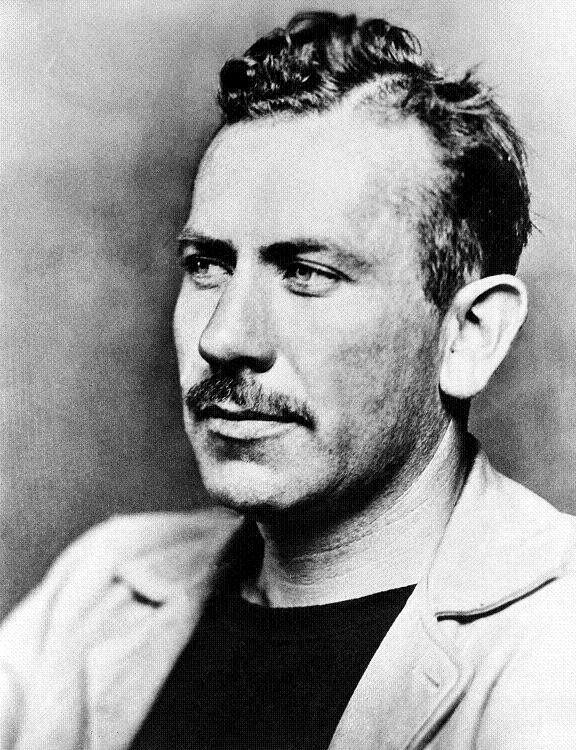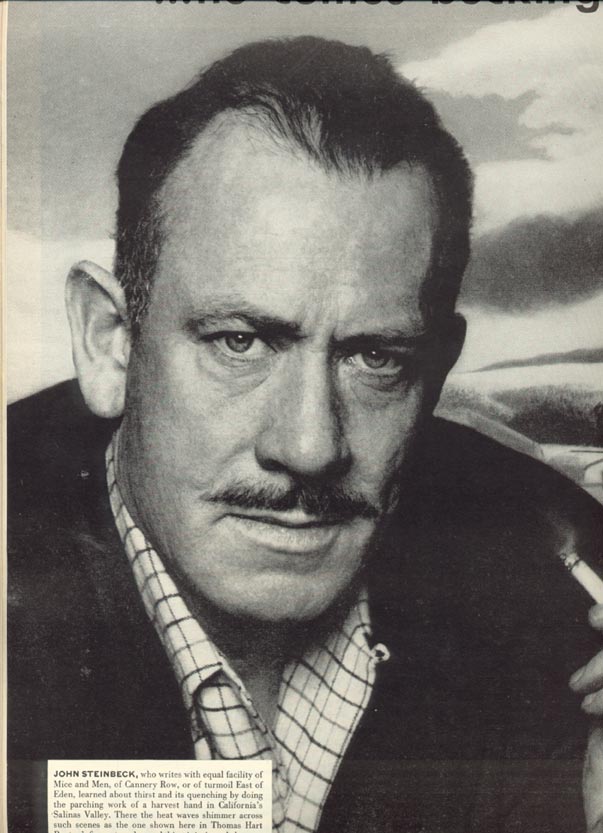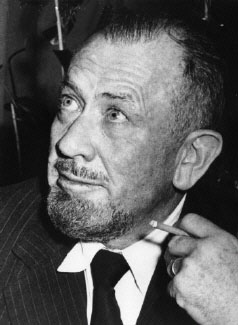<Back to Index>
- Philosopher Rudolf Joseph Lorenz Steiner, 1861
- Novelist John Ernst Steinbeck, Jr., 1902
- 1st President of Iceland Sveinn Björnsson, 1881
PAGE SPONSOR



John Ernst Steinbeck, Jr. (February 27, 1902 – December 20, 1968) was an American writer. He wrote the Pulitzer Prize winning novel The Grapes of Wrath (1939) and the novella Of Mice and Men (1937). He wrote a total of twenty-seven books, including sixteen novels, six non-fiction books and five collections of short stories. In 1962, Steinbeck received the Nobel Prize for Literature.
John Ernst Steinbeck, Jr was born on February 27, 1902, in Salinas, California. He was of German and Irish descent. Johann Adolf Großsteinbeck, Steinbeck's paternal grandfather, had shortened the family name to Steinbeck when he immigrated to the United States. The family farm in Heiligenhaus, Germany, is still today named "Großsteinbeck". His father, John Steinbeck Sr., served as Monterey County Treasurer. John's mother, Olive Hamilton, a former school teacher, shared Steinbeck's passion of reading and writing. Steinbeck lived in a small rural town that was essentially a frontier settlement, set amid some of the world's most fertile land. He spent his summers working on nearby ranches and later with migrant workers on Spreckels ranch. He became aware of the harsher aspects of migrant life and the darker side of human nature, which material expressed in such works as Of Mice and Men. He also explored his surroundings, walking across local forests, fields, and farms.
In 1919, Steinbeck graduated from Salinas High School and attended Stanford University intermittently until 1925, eventually leaving without a degree. He traveled to New York City and held odd jobs while pursuing his dream of becoming a writer. When he failed to get his work published, he returned to California and worked for a time in 1928 as a tour guide and caretaker at the fish hatchery in Tahoe City, where he would meet tourist Carol Henning, his future first wife. Steinbeck and Henning were married in January 1930.
Steinbeck lived most of the years of the Great Depression and his marriage to Carol in a cottage that was owned by his father in Pacific Grove, California, on the Monterey Peninsula a few blocks from the border of Monterey city. The elder Steinbeck supplied him with the lodging for free, with paper for his manuscripts, and critical loans beginning at the end of 1928 which allowed Steinbeck to give up a punishing warehouse job in San Francisco, and focus on his craft.
After the publication of his Monterey novel Tortilla Flat in 1935, his first clear novelistic success, the Steinbecks emerged from relative poverty and built a summer ranch-home in Los Gatos. In 1940, Steinbeck went on a voyage around the Gulf of California with his influential friend Ed Ricketts, to collect biological specimens. The Log from the Sea of Cortez describes
his experiences. Although Carol accompanied Steinbeck on the trip,
their marriage was beginning to suffer by this time, and would
effectively end in 1941, even as Steinbeck worked on the manuscript for
the book. In 1943, Steinbeck filed for divorce against Carol and married Gwyndolyn "Gwyn" Conger, with whom he had two children - Thomas ("Thom") Myles Steinbeck in 1944 and John Steinbeck IV (1946 – 1991). Steinbeck and his second wife divorced in 1948. In December 1950, Steinbeck married stage manager Elaine Scott within a week of the finalizing of her divorce from actor Zachary Scott. This marriage lasted until Steinbeck's death in 1968. In 1948, Steinbeck toured the Soviet Union with renowned photographer Robert Capa. They visited Moscow, Kiev, Tbilisi, Batumi and Stalingrad. His book about their experiences, A Russian Journal, was illustrated with Capa's photos. That year he was elected to the American Academy of Arts and Letters. In 1966, Steinbeck traveled to Tel Aviv to visit the site of Mount Hope, a farm community established in Israel by his grandfather, whose brother, Friedrich Grosssteinbeck, was murdered by Arab marauders on January 11, 1858. John Steinbeck died in New York City on December 20, 1968 of heart disease and congestive heart failure. He was 66, and had been a life-long smoker. An autopsy showed nearly complete occlusion of the main coronary arteries. In accordance with his wishes, his body was cremated, and an urn containing his ashes was eventually interred (March 4, 1969) at
the Hamilton family gravesite at Garden of Memories Memorial Park in
Salinas, with those of his parents and maternal grandparents. His third wife, Elaine, was buried in the plot in 2004. He
had earlier written to his doctor that he felt deeply "in his flesh"
that he would not survive his physical death, and that the biological
end of his life was the final end to it. Steinbeck's first novel, Cup of Gold, published in 1929, is based on the life and death of privateer Henry Morgan. It centers on Morgan's assault and sacking of the city of Panama, sometimes referred to as the 'Cup of Gold', and on the woman, fairer than the sun, who was said to be found there. After Cup of Gold, between 1931 and 1933 Steinbeck produced three shorter works. The Pastures of Heaven, published in 1932, comprised twelve interconnected stories about a valley near Monterey, that was discovered by a Spanish corporal while chasing runaway American Indian slaves. In 1933 Steinbeck published The Red Pony, a 100-page, four chapter story weaving in memories of Steinbeck's childhood. To a God Unknown follows the life of a homesteader and his family in California, depicting a character with a primal and pagan worship of the land he works. Steinbeck achieved his first critical success with the novel Tortilla Flat (1935), which won the California Commonwealth Club's Gold Medal. The book portrays the adventures of a group of classless and usually homeless young men in Monterey after World War I, just before U.S. prohibition.
The characters, who are portrayed in ironic comparison to mythic
knights on a quest, reject nearly all the standard mores of American
society in enjoyment of a dissolute life centered around wine, lust,
camaraderie and petty theft. The book was made into the 1942 film Tortilla Flat, starring Spencer Tracy, Hedy Lamarr and John Garfield, a friend of Steinbeck's. Steinbeck began to write a series of "California novels" and Dust Bowl fiction, set among common people during the Great Depression. These included In Dubious Battle, Of Mice and Men and The Grapes of Wrath. Of Mice and Men, about the dreams of a pair of migrant laborers working the California soil, was critically acclaimed. The stage adaptation of Of Mice and Men was a hit, starring Broderick Crawford as the mentally child-like but physically powerful itinerant farmhand "Lennie," and Wallace Ford as
Lennie's companion, "George." However, Steinbeck refused to travel from
his home in California to attend any performance of the play during its New York run, telling Kaufman that the play as it existed in his own mind was
"perfect" and that anything presented on stage would only be a
disappointment. Steinbeck would write two more stage plays (The Moon Is Down and Burning Bright). Of Mice and Men was rapidly adapted into a 1939 Hollywood film, in which Lon Chaney, Jr. (who had portrayed the role in the Los Angeles production of the play) was cast as Lennie and Burgess Meredith as "George." Steinbeck followed this wave of success with The Grapes of Wrath (1939),
based on newspaper articles he had written in San Francisco. The novel
would be considered by many to be his finest work. It won the Pulitzer Prize in 1940, even as it was made into a notable film directed by John Ford, starring Henry Fonda as Tom Joad, who was nominated for an Academy Award for the part. The success of The Grapes of Wrath was not free of controversy, as Steinbeck's liberal political views, portrayal of the negative side of capitalism, and mythical reinterpretation of the historical events of the Dust Bowl migrations led to backlash against the author, especially close to home. In fact, claiming the book was both obscene and misrepresented conditions in the county, the Kern County Board of Supervisors banned the book from the county's public schools and libraries in August 1939. This ban lasted until January 1941. Of the controversy, Steinbeck wrote, "The vilification of me out here from the large landowners and bankers is pretty bad. The latest is a rumor started by them that the Okies hate
me and have threatened to kill me for lying about them. I'm frightened
at the rolling might of this damned thing. It is completely out of
hand; I mean a kind of hysteria about the book is growing that is not healthy." The film versions of The Grapes of Wrath and Of Mice and Men (by two different movie studios) were in production simultaneously, allowing Steinbeck to spend a full day on the set of The Grapes of Wrath and the next day on the set of Of Mice and Men. In the 1930s and 1940s, Ed Ricketts strongly
influenced Steinbeck's writing. Steinbeck frequently took small trips
with Ricketts along the California coast to give Steinbeck time off
from his writing and to collect biological specimens, which Ricketts sold for a living. Their joint book about a collecting expedition to the Gulf of California in
1940, which was part travelogue and part natural history, published
just as the U.S. entered World War II, never found an audience and did
not sell well. However, in 1951, Steinbeck republished the narrative portion of the book as The Log from the Sea of Cortez, under his name only (though Ricketts had written some of it). This work remains in print today. Ricketts was Steinbeck's model for the character of "Doc" in Cannery Row (1945) and Sweet Thursday (1954), "Friend Ed" in Burning Bright, and characters in In Dubious Battle (1936) and The Grapes of Wrath (1939). Ecological themes recur in Steinbeck's novels of the period. Steinbeck's
close relations with Ricketts ended in 1941 when Steinbeck moved away
from Pacific Grove and split with his wife Carol. Ricketts' biographer Eric Enno Tamm notes that, except for East of Eden (1952), Steinbeck's writing declined after Ricketts' untimely death in 1948. His novel The Moon is Down (1942), about the Socrates inspired spirit of resistance in a Nazi occupied
village in northern Europe, was made into a film almost immediately. It
was presumed that the unnamed country of the novel was Norway, and in 1945 Steinbeck received the Haakon VII Medal of freedom for his literary contributions to the Norwegian resistance movement. In 1943, Steinbeck served as a World War II war correspondent for the New York Herald Tribune and worked with the Office of Strategic Services (predecessor of the CIA). It was at that time he became friends with Will Lang Jr. of Time/Life magazine. During the war, Steinbeck accompanied the commando raids of Douglas Fairbanks, Jr.'s Beach Jumpers program, which launched small-unit diversion operations against German held islands in the Mediterranean. Some of his writings from this period were incorporated in the documentary Once There Was A War (1958). Steinbeck
returned from the war with a number of wounds from shapnel and some
psychological trauma. He treated himself, as ever, by writing. He wrote Alfred Hitchcock's Lifeboat (1944), and the film A Medal for Benny (1945) with screenwriter Jack Wagner about paisanos from Tortilla Flat going to war. He later requested that his name be removed from the credits of Lifeboat because
he believed the final version of the film had racist undertones. In
1944, suffering from homesickness for his Pacific Grove / Monterey life
of the 1930s, he also wrote Cannery Row (1945) which became so famous that Ocean View Avenue in Monterey, the location of the book, was eventually renamed Cannery Row in 1958. After the end of the war, he wrote The Pearl (1947), already knowing it would be filmed. The story first appeared in the December 1945 issue of Woman's Home Companion magazine as "The Pearl of the World." It was illustrated by John Alan Maxwell. The novel is an imaginative telling of a story which Steinbeck had heard in La Paz in 1940, as related in The Log From the Sea of Cortez,
which he described in Chapter 11 as being "so much like a parable that
it almost can't be". Steinbeck traveled to Mexico for the filming with
Wagner who helped with the script; on this trip he would be inspired by
the story of Emiliano Zapata, and subsequently wrote a film script (Viva Zapata!) directed by Elia Kazan and starring Marlon Brando and Anthony Quinn. After
his divorce from Gwyndolyn Conger and the death of Ed Ricketts (when
his car was hit by a train in 1948), Steinbeck married for the last
time in 1950. Soon after, he began work on East of Eden (1952), which he considered his best work. In 1952, John Steinbeck appeared as the on-screen narrator of 20th Century Fox's film, O. Henry's Full House.
Although Steinbeck later admitted he was uncomfortable before the
camera, he provided interesting introductions to several filmed
adaptations of short stories by the legendary writer O. Henry. About the same time, Steinbeck recorded readings of several of his short stories for Columbia Records; despite some stiffness, the recordings provide a record of Steinbeck's deep, resonant voice. Following the success of Viva Zapata!, Steinbeck collaborated with Kazan on East of Eden, James Dean's film debut. Travels with Charley (subtitle: In Search of America) is a travelogue of his 1960 road trip with his poodle Charley.
Steinbeck bemoans his lost youth and roots, while dispensing both
criticism and praise for America. According to Steinbeck's son Thom,
Steinbeck went on the trip because he knew he was dying and wanted to
see the country one last time. Steinbeck's last novel, The Winter of Our Discontent (1961), examines moral decline in America. The protagonist Ethan grows discontented with his own moral decline and that of those around him. The
book is very different in tone from Steinbeck's amoral and ecological
stance in earlier works like Tortilla Flat and Cannery Row. It was not
a critical success. Many reviewers recognized the importance of the
novel but were disappointed that it was not another Grapes of Wrath. Apparently
taken aback not only by the critical reception of this novel, but also
the critical outcry when he was awarded the Nobel Prize for Literature
in 1962, Steinbeck attempted to publish no more fiction in the next six
years before his death. In
1962, Steinbeck won the Nobel Prize for literature for his “realistic
and imaginative writing, combining as it does sympathetic humor and
keen social perception.” On the day of the announcement (Oct. 25) when
he was asked by a reporter at a press conference given by his
publisher, if he thought he deserved the Nobel, he said: "Frankly, no." In his acceptance speech later in the year in Stockholm, he said: Although
modest about his own talent as a writer, Steinbeck talked openly of his
own admiration of certain writers. In 1953, he wrote that he considered
cartoonist Al Capp, creator of the satirical Li'l Abner, "possibly the best writer in the world today." At
his own first Nobel Prize press conference he was asked his favorite
authors and works and replied: "Hemingway's short stories and nearly
everything Faulkner wrote." In September 1964, Steinbeck was awarded the United States Medal of Freedom by President Lyndon B. Johnson. In 1967, at the behest of Newsday magazine, Steinbeck went to Vietnam to report on the war there. Thinking of the Vietnam War as a heroic venture, he was considered a hawk for
his position on that war. His sons both served in Vietnam prior to his
death, and Steinbeck visited one son in the battlefield (at one point
being allowed to man a machine-gun watch position at night at a firebase, while his son and other members of his platoon slept). After Steinbeck's death, his incomplete novel based on the King Arthur legends of Malory and others, The Acts of King Arthur and His Noble Knights, was finally published in 1976. On Feb. 27, 1979, on what would have been his 77th birthday, he was honored by being placed on a U.S. postage stamp.